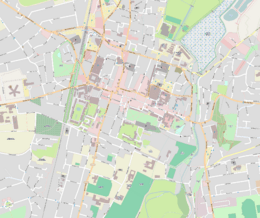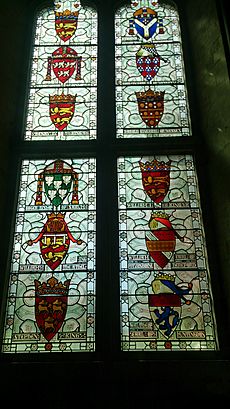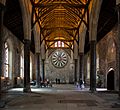Winchester Castle facts for kids
Quick facts for kids Winchester Castle |
|
|---|---|
| Hampshire, England | |

The Great Hall, built by Henry III
|
|
| Coordinates | 51°03′45″N 1°19′14″W / 51.06243°N 1.32054°W grid reference SU476295 |
| Site information | |
| Owner | Hampshire County Council |
| Condition | Great Hall remains, used as museum |
| Site history | |
| Materials | Stone |
| Battles/wars | The Anarchy English Civil War |
| Events | Trial of Walter Raleigh Bloody Assizes |
Winchester Castle is an old building from the Middle Ages located in Winchester, Hampshire, England. It was started in 1067. Today, only the Great Hall is left. This hall is now a museum that shares the history of Winchester.
Contents
History of Winchester Castle
How Winchester Castle Began
Long ago, around AD 70, the Romans built a huge earth wall here. It was about 244 meters (800 feet) long and 61 meters (200 feet) wide. They put a fort on top of this wall to protect their city, Venta Belgarum. Later, William the Conqueror chose this very spot to build one of the first Norman castles in England.
The castle was built in 1067. For over a hundred years, it was the main place where the Norman Kings ruled. King Henry II added a stone tower to keep the royal money and the important Domesday Book. You can still see a round tower from the first castle, which has secret exits called sally ports. In 1141, during a time of civil war called The Anarchy, the castle was attacked. Forces loyal to Empress Matilda were surrounded by the army of King Stephen in an event known as the Rout of Winchester.
Building the Great Hall
Between 1222 and 1235, King Henry III added the Great Hall. King Henry III was actually born at Winchester Castle. He designed the Great Hall to be very large, measuring about 33.5 meters (110 feet) long, 16.7 meters (55 feet) wide, and 16.7 meters (55 feet) high.
The Great Hall was built using flint stones with special stone decorations. At first, it had lower walls and a roof with small windows called dormer windows. These were later replaced with tall, two-part windows that had early stone patterns called tracery. The Great Hall is a very important historical building, listed as Grade I.
In 1287, a man named Asher, who was the son of Licoricia of Winchester, wrote a Hebrew message on the ruins of the Jews' Tower. This tower was part of the castle. This message was written when many Jewish people were held prisoner on May 2, 1287. This happened before a large tax was placed on them by King Edward I, and before they were forced to leave England in 1290.
Later, King Edward II also added more parts to the castle.
A famous Arthurian Round Table was hung in the Great Hall. This table was first made in the 13th century. It was repainted for King Henry VIII to look as it does today. Around the edge of the table, the names of King Arthur's knights were painted. The picture of King Arthur on the table looks a lot like a young King Henry VIII. There were also special pictures called the Winchester Panels in the Great Hall. These pictures are thought to show the 25 knights of the Round Table and teach lessons about growing up.
Later Years of the Castle
In 1302, King Edward I and his second wife, Queen Margaret of France, almost died when the royal living areas of the castle caught fire. On March 19, 1330, Edmund of Woodstock, 1st Earl of Kent was executed outside the castle walls. This was part of a plan against King Edward III. The castle remained an important royal home. On April 10, 1472, Margaret of York, who was the daughter of King Edward IV, was born there.
In 1580, a nun named Elizabeth Sander was held prisoner here with other Catholics. She escaped but returned to show that Catholics followed the law. After Queen Elizabeth I became queen in 1558, the castle was no longer a royal home. It was given to the city of Winchester.
On November 17, 1603, Sir Walter Raleigh was put on trial for treason in the Great Hall. He was accused of being part of a plot against the king. The castle was used by the Royalists during the English Civil War. It was taken by the Parliamentarians in 1646. Then, in 1649, it was torn down by order of Oliver Cromwell.
Later in the 17th century, King Charles II planned to build a new royal palace next to the castle site. He hired Christopher Wren to design a palace that would be as grand as the Palace of Versailles. However, the project was stopped by King James II. It was in the Great Hall that, after the Monmouth Rebellion, Judge Jeffreys held the Bloody Assizes on August 27, 1685. During these trials, Alice Lisle was sentenced to death for helping people who were running away.
Today, Castle Hill, which is nearby, is where the Council Chamber for Hampshire County Council is located. Since 2014, it has also been home to the Winchester Register Office. The Great Hall was also used for important court cases. In 1954, a well-known trial took place there. The Great Hall stopped being used for criminal trials after the Winchester Law Courts were built in 1974, just east of the Great Hall.
Behind the Great Hall, a garden in the style of the Middle Ages was created in 1986. It is called Queen Eleanor's Garden.
Winchester Castle is also very close to the Westgate, which is part of the old city wall.
As of 2024, the Great Hall is managed by Hampshire Cultural Trust. They market it as The Great Hall with Westgate Museum.
Gallery
See also
 In Spanish: Castillo de Winchester para niños
In Spanish: Castillo de Winchester para niños
- Castles in Great Britain and Ireland
- List of castles in England
- Three Castles Path







